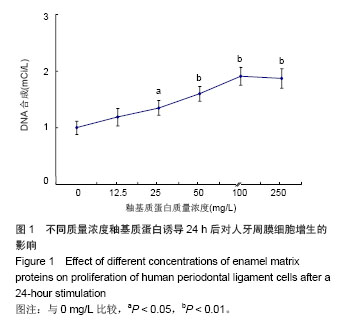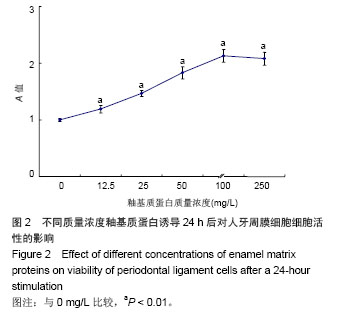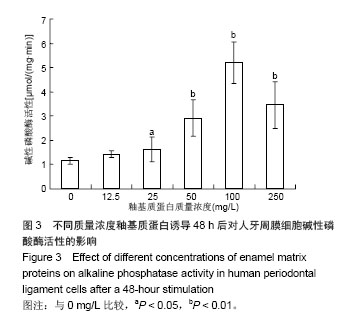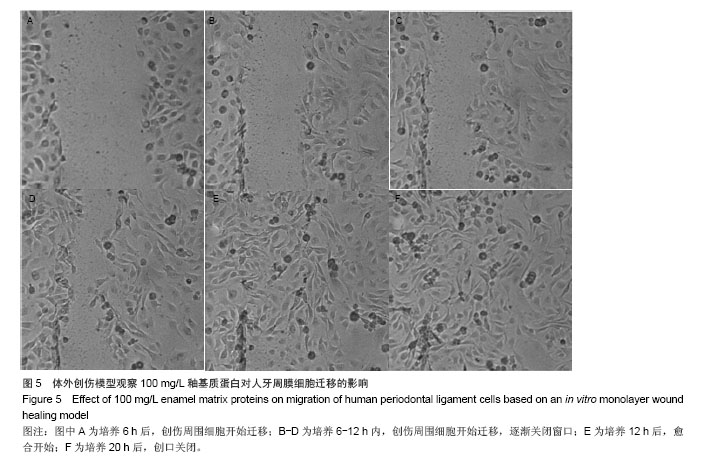| [1]蒋少云,束蓉.釉基质蛋白促进牙周组织再生机制的研究进展[J].牙体牙髓牙周病学杂志,2008,17(9):535-538.
[2]邹慧儒,秦宗长,张兰成.釉基质蛋白各组成成分及其作用[J].国际口腔医学杂志,2013,40(3):355-258.
[3]Qu Z,Laky M,Ulm C,et al. Effect of Emdogain on proliferation and migration of different periodontal tissue-associated cells[J].Oral Surg Oral Med Oral Pathol Oral Radiol Endod. 2010;109(6):924-931.
[4]DiPietro LA.Oral Stem Cells: The Fountain of Youth for Epithelialization and Wound Therapy? Adv Wound Care(New Rochelle).2014;3(7):465-467.
[5]Rodionova NV.The dynamics of proliferation and differentiation of osteogenic cells under supportive unloading. Tsitol Genet.2011;45(2):22-27.
[6]Rausch-fan X,Qu Z,Wieland M,et al.Differentiation and cytokine synthesis of human alveolar osteoblasts compared to osteoblast-like cells (MG63) in response to titanium surfaces. Dent Mater.2008;24(1):102-110.
[7]Bertl K,An N,Bruckmann C,et al.Effects of enamel matrix derivative on proliferation/viability, migration, and expression of angiogenic factor and adhesion molecules in endothelial cells in vitro.J Periodontol.2009;80(10):1622-1630.
[8]Filippi A,Pohl Y,von Arx T.Treatment of replacement resorption by intentional replantation, resection of the ankylosed sites, and Emdogain--results of a 6-year survey.Dent Traumatol.2006;22(6):307-311.
[9]侯小丽,吴织芬,万玲,等.釉基质蛋白对骨髓基质细胞分泌TGF-β1的影响[J].牙体牙髓牙周病学杂志,2004,14(4):194-196.
[10]Miron RJ ,Wei L,Yang S,et al. Effect of an Enamel Matrix Derivative on Periodontal Wound Healing/Regeneration in an Osteoporotic Model.J Periodontol.2014;26(3):1-12.
[11]Ninomiya M,Kamata N,Fujimoto R,et al.Application of enamel matrix derivative in autotransplantation of an impacted maxillary premolar: a case report.J Periodontol. 2002;73(3): 346-351.
[12]Döri F,Arweiler NB,Szántó E,et al.Ten-year results following treatment of intrabony defects with an enamel matrix protein derivative combined with either a natural bone mineral or a β-tricalcium phosphate.J Periodontol.2013;84(6):749-757.
[13]项陈洋,张凌琳,李伟.釉基质蛋白在口腔医学领域中的应用进展[J].国际口腔医学杂志,2012,39(6):766-769.
[14]Obregon-Whittle MV,Stunes AK,Almqvist S,et al.Enamel matrix derivative stimulates expression and secretion of resistin in mesenchymal cells.Eur J Oral Sci.2011;119 Suppl 1:366-372.
[15]Grandin HM,Gemperli AC,Dard M.Enamel matrix derivative: a review of cellular effects in vitro and a model of molecular arrangement and functioning.Tissue Eng Part B Rev.2012; 18(3):181-202.
[16]Matsumoto N,Minakami M,Hatakeyama J,et al.Histologic Evaluation of the Effects of Emdogain Gel on Injured Root Apex in Rats.J Endod.2014;40(12):1989-1994.
[17]Ferreira MM,Filomena BM,Lina C,et al.The effect of Emdogain gel on periodontal regeneration in autogenous transplanted dog's teeth.Indian J Dent Res. 2014;25(5): 589-593.
[18]Izumi Y,Aoki A,Yamada Y,et al.Current and future periodontal tissue engineering. Periodontol 2000.2011;56(1):166-187.
[19]宋忠臣,束蓉,宋爱梅,等.釉基质蛋白对人骨髓基质细胞生长和黏附的影响[J].上海口腔医学,2006,15(6):601-604.
[20]宋忠臣,束蓉,谢玉峰.釉基质蛋白对人骨髓基质细胞增殖和矿化的影响[J].上海口腔医学,2008,24(6):831-834.
[21]won YD,Choi HJ,Lee H,et al.Cellular viability and genetic expression of human gingival fibroblasts to zirconia with enamel matrix derivative (Emdogain®).J Adv Prosthodont. 2014;6(5):406-414.
[22]de Oliveira MT,Bentregani LG,Pasternak B,et al.Histometric study of resorption on replanted teeth with enamel matrix-derived protein.J Contemp Dent Pract. 2013;14(3): 468-472.
[23]Jabbari E.Osteogenic peptides in bone regeneration(R).Curr Pharm Des. 2013;19(19):3391-402.
[24]Amin HD,Olsen I,Knowles JC,et al.Effects of enamel matrix proteins on multi-lineage differentiation of periodontal ligament cells in vitro.Acta Biomater. 2013;9(1):4796-4805.
[25]Wada Y,Mizuno M,Nodasaka Y,et al.The effect of enamel matrix derivative on spreading, proliferation, and differentiation of osteoblasts cultured on zirconia.Int J Oral Maxillofac Implants.2012;27(4):849-858.
[26]张凤秋,孟焕新,韩劫,等.釉基质蛋白对人牙周膜细胞生物学影响的体外研究[J].北京大学学报:医学版,2012,44(1):6-10.
[27]刘兰宁,刘宏伟,金岩,等.釉基质蛋白对牙周膜成纤维细胞合成蛋白的影响[J].中国临床康复,2005,9(30):104-106.
[28]李玲,王茜.3种根尖倒充填材料对体外人牙周韧带细胞创伤模型创面愈合的影响[J].上海口腔医学,2011,20(1):41-45.
[29]Yan XZ,Rathe F,Gilissen C,et al.The effect of enamel matrix derivative (Emdogain®) on gene expression profiles of human primary alveolar bone cells.J Tissue Eng Regen Med.2014; 8(6):463-472.
[30]Miron RJ,Bosshardt DD,Zhang Y,et al.Gene array of primary human osteoblasts exposed to enamel matrix derivative in combination with a natural bone mineral.Clin Oral Investig. 2013;17(2):405-410. |





.jpg)